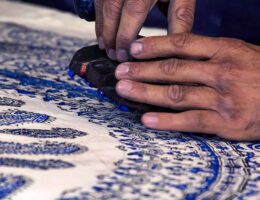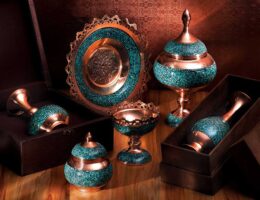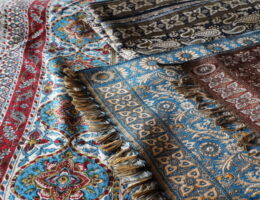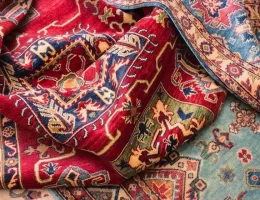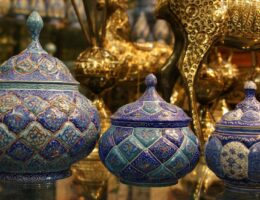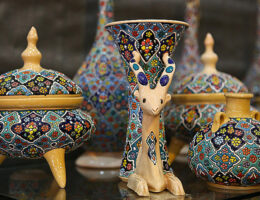IRAN ART EXHIBITION: the most well-known Handicrafts of Iran
Woods and bones, copper and silver, gold and gemstones, silk and wool, are all the raw materials turn into exquisite Iran handicrafts by the artist craftsmen and craftswomen in the country. They do a miracle and pour their feelings and cultural concepts into these traditional handicrafts of Iran. That is the reason Persian handicrafts are priceless, whereas other artworks in the world. Keep up with this record to know more about Iran handicrafts and Iranian handmade arts.
Top 10 Iran Handicrafts:
1. Khatam Kari: Marquetry with Wood, Metal, Bone
2. Ghalam Zani: Hammer and Nail Metal Engraving
3. Mina Kari: Enamel Painting on Copper, Silver, Gold
4. Firoozeh Koubi: Turquoise Stone Inlaying
5. Miniature: Miniature Hand Painting
6. Carpet Weaving: Knotting Silken and Woolen Threads
7. Termeh Weaving: Luxury Quilted Textile
8. GhalamKar: Hand-Printed Textile
9. Giveh Weaving: Making Hand-Woven Shoes
10. Pottery: Baked-Clay Forming
Iran Handicrafts:
As a vast land, Iran offers thousands of handicrafts and artworks manifesting the prolific Iranian culture. It is not easy to introduce all Iran handicrafts in a brief record, but here you will read about some best Iranian handicrafts that are well-reputed in the world.
1. Khatam Kari: Marquetry with Wood, Metal, Bone
As one of the most exquisite Iran handicrafts, Khatam Kari is the art of inlaying small pieces of wood, bone, or metal on the surface of different articles. Incrusted patterns (geometrical shapes, particularly star-shaped) are produced in this Iranian handmade art, with thin sticks of wood (ebony, teak, orange, and rose), brass (for the golden parts), and camel bone (white sections). The sticks are then assembled in triangular beams that are themselves glued in a strict order to create a cylinder with a geometrical motif, such as a six-branch star included in a hexagon. The cylinders are cut into shorter ones and then compressed and dried between two wooden plates. These sections are ready to be plated and glued on the object, before lacquer finishing. Among all handicrafts of Iran, Khatamkari is highly elaborated. In each cubic centimeter of space, up to approximately 250 pieces of metal, bone (usually camel bone), ivory, and wood are laid side by side. Dating back to the Safavid era, Khatam Kari is one of the oldest Persian handicrafts, still practiced in Isfahan, Shiraz, and Kerman.
2. Ghalam Zani: Hammer and Nail Metal Engraving
IRAN ART EXHIBITION: Ghalam Zani is one of the most elegant Persian arts and Iranian handicrafts. Ghalamzani is the art of craving detailed, splendid Persian designs on various metals, including copper, brass, silver, and gold by hammer and chisel (Ghalam). Persian metalwork engraving is known as the best-documented artistic medium from Iran in the Islamic period. The historical discoveries of this traditional handicraft of Iran date back to the ancient times as the Sassanid (700 A.D.), the Seljuk (100 A.D.), and the Safavid (1600 A.D.) dynasties. This Iranian handicraft was then revived by Master Mohammad Oraizi and Master Mohammad Taghi Zoufan during the past 80 years. Now, you can find various objects and utensils, including plates, trays, candy boxes, candlesticks, etc., which are elegantly engraved in Iran handicraft shops, particularly in Isfahan, Shiraz, and Tehran.
Mina Kari:
As a well-known Sassanid handicraft of Iran, Mina Kari is being observed on the doors and chandeliers of vintage palaces, mansions, and shrines that you may visit during an Iran historical tour.
3. Mina Kari: Enamel Painting on Copper, Silver, Gold
Mina Kari (or enameling) is one of the most celebrated handicrafts of Iran, mostly practiced in Isfahan and Shiraz. Minakari is the art of coloring and ornamenting the surface of metals (and even potteries) by fusing brilliant colors over them. Mina (comes from Minoo, which means heaven) is defined as a glass-like colored coat that can be stabilized by heat (usually between 750 to 850 degrees of Celsius) on various metals, such as copper. This splendid art (produced by lots of Persian handicraft suppliers) is applied in making wall hanging plates, home décor, candy dishes, vases, and jewelry. As a well-known Sassanid handicraft of Iran, Mina Kari is being observed on the doors and chandeliers of vintage palaces, mansions, and shrines that you may visit during an Iran historical tour.

4. Firoozeh Koubi: Turquoise Stone Inlaying
Among the most exquisite handicrafts of Iran, Firooze Koubi is a very popular one. This Iranian handicraft is one of the Iran souvenirs produced by a large number of Persian handicraft suppliers. In turquoise inlaying art, small pieces of turquoise are set in mosaic fashion on the surface of various metals (coppers, brass, silver, and gold) to give the object a special glamor. Not only decorative dishes and utensils but also elegant accessories, including necklaces, rings, earrings, etc., can be ornamented by the small pieces of this precious gemstone. Turquoise stone inlaid dishes are among the most cost-effective handicraft in Iran, and many foreigners purchase them during their Iran shopping.
5. Miniature: Miniature Hand Painting
The miniature is an exquisite Iranian handmade painting on paper or more importantly, on a piece of camel bone. The techniques of this Persian handicraft are comparable to the Western and Byzantine traditions of the miniature in illuminated manuscripts. The brilliant and authentic coloring of this handicraft of Iran is one of its most striking features. As one of the best Iranian handicrafts, miniature paintings could be found in many Iran handicraft shops. Miniature painting became a significant Iranian handicraft in the 13th century, receiving Chinese influence, and it flourished in the 15th and 16th centuries. The tradition continued under some Western impressions and turned into a dominant influence on other Islamic miniature traditions, principally the Ottoman miniature in Turkey and the Mughal miniature in the Indian sub-continent.
6. Carpet Weaving: Knotting Silken and Woolen Threads
IRAN ART EXHIBITION: Persian carpet, the narrator of the Persian arts, is considered one of the best Iranian handicrafts. It has a global reputation, and you can find this precious Persian handicraft in all corners of the universe. Alexander Pope states: “Iranian carpets are the symbol of poetic luxury.”, and he is perfectly right! These authentic Iran handicrafts, designed by ravishing patterns, are woven in a wide range of variety. Every city manifests its own carpet style according to the cultural tastes of the weavers’ skilled hands. Persian carpets were first mentioned around 400 B.C. by the Greek author Xenophon; however, flat weaving dates back to the Sassanid dynasty, when Iranian silk textiles were preserved in European churches as coverings for relics. In most Persian carpets, sheep’s wool and silk threads are knotted to form fascinating designs. High-quality carpets from Qom, Tabriz, Kashan, Nain, and Isfahan have all-silk piles that are sometimes used as wall-hangings as well. The more the number of knots, the higher the quality will be.
7. Termeh Weaving: Luxury Quilted Textile
Termeh, a handicraft made with high-quality threads, is a hand-woven colorful textile with special patterns, mainly paisley which was originated in Yazd. Termeh handicraft is a soft and elegant cloth which is made of various threads material, including silk, wool, and fluff. Termeh industry was very prosperous because of its popularity and different usages by the upper class of society until factory-made clothes and textiles were imported into the markets. Weaving Termeh handicraft is a careful and time-consuming work. Dating back to the beginning of the Safavid era, Termeh weaving is an old handicraft in Iran.
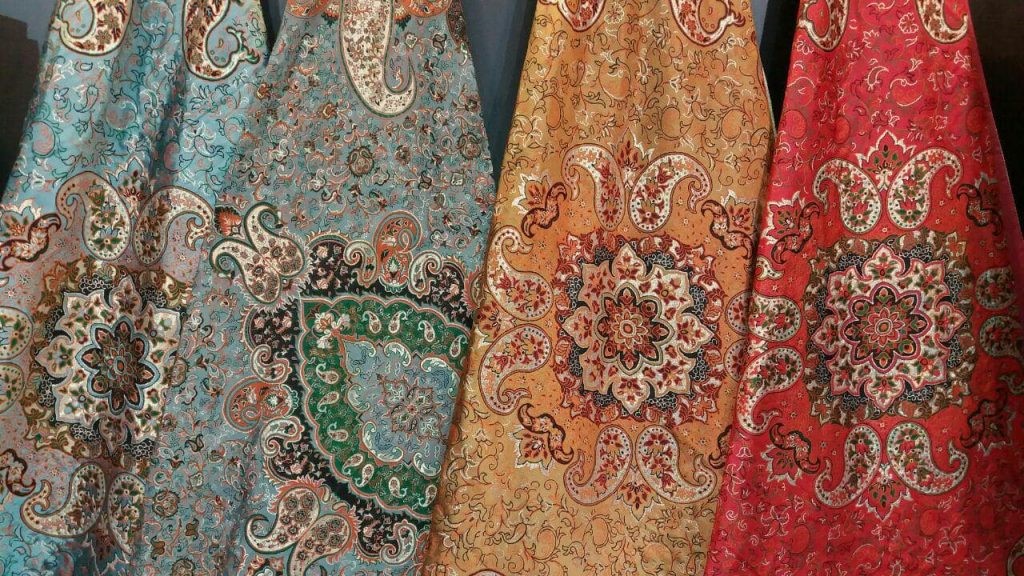
8. GhalamKar: Hand-Printed Textile
Ghalamkar fabric is a type of textile-printing, patterned Iranian designs. The fabric is printed using patterned wooden stamps, made of pear wood which has better flexibility and density for carving and long-standing utility. A tapestry may be stamped depending on its density and size, between hundreds and tens of thousands of times. For example, a two-meter by 1.4-meter piece should be stamped about 580 times up to 4000 times in an elegant work. Ghalamkar is one of the most popular Iran handicrafts, mostly produced in Isfahan.
Giveh:
The materials used in Giveh weaving let the air circulate from its tiny pores; therefore, it is very suitable for hot summer days.
9. Giveh Weaving: Making Hand-Woven Shoes
Giveh is a light and easy-to-wear Iranian handmade shoe in which a special material (usually carpet yarn) is woven by skilled hands of rural men and women. As a small home-industry, Giveh weaving is one of the traditional handicrafts of Iran. This footwear used to be very popular all over the country till a couple of decades ago. The materials used in Giveh weaving let the air circulate from its tiny pores; therefore, it is very suitable for hot summer days. This Iranian handicraft is produced in different colors in various cities of Iran, including Kermanshah, Zanjan, Shiraz, etc.
10. Pottery: Baked-Clay Forming
IRAN ART EXHIBITION: The history of the art of pottery in Iran goes back to ancient times around 4000 B.C. when agriculture came into existence and cultivation started on Iran plateau by primitive races of this land, and people made utensils of baked clay to meet their needs. Before glass manufacturing became widespread, most dishes used by humans, such as pitchers and bowls were pottery. Nowadays, pottery has turned into one of the most popular traditional handicrafts of Iran. The best performing soil for this Persian handicraft is clay, which is of a large amount of Iron red. Hundreds of Persian handicraft suppliers in Lalejin (Hamedan) and Meybod (Yazd) are producing exquisite colorful potteries.

